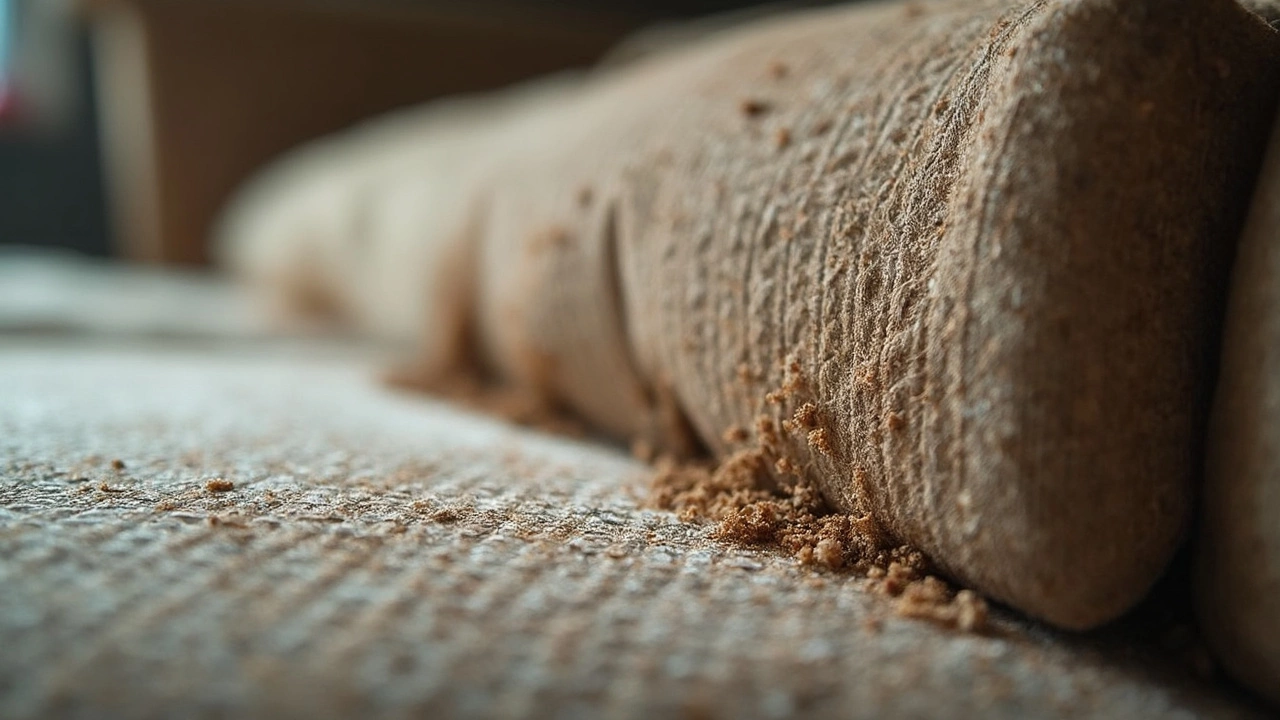Ever finished scrubbing your couch only to find it looks even grubbier than when you started? You probably stared at those mysterious streaks or patches, wondering if you made things worse. Turns out, there are real reasons why sofas sometimes look dirtier after a good cleaning. Sofa care is a bit trickier than most folks think—even that lush velvet number in your living room has a hidden temper. If you’ve tried to deal with a stubborn stain and ended up making your couch look like it had a mud bath instead, you’re definitely not the only one.
The Science Behind Residue and Stains: Why Cleaning Can Backfire
Couches see it all—coffee spills, chocolate smears, pet hair, even random smudges from sticky fingers. But what you might not know is that upholstery is super picky about what it likes. A lot of household cleaners (even ones that say "safe for fabric") often leave behind tiny particles called residues. These residues act like magnets for new dirt. If your freshly cleaned sofa suddenly seems to collect grime at triple speed, residue is the likely culprit. It sticks to the fibres, dulls colours, and attracts every bit of dust in the room.
The same thing can happen with cleaning solutions that aren’t thoroughly rinsed out. If you use too much soap or don’t blot it right, you’re basically soaking your couch in sticky leftovers instead of getting it clean. Here’s a neat fact: according to a 2022 study done by the British Institute of Cleaning Science, improper rinsing and overuse of detergent are among the top three reasons for upholstery re-soiling within the first week after cleaning.
But that's not all. Cleaning with water alone can actually make things worse for certain fabrics. Tap water contains minerals (like calcium and magnesium), which can leave marks—especially on dark or delicate materials. This is why water stains are so common and tricky to get rid of. Also, if your sofa wasn’t vacuumed thoroughly first, dirt gets ground deeper into the fibres when you start scrubbing. So, instead of removing grime, you embed it further in, leaving those muddy-looking patches.
That dramatic change in appearance isn’t always about dirt, though. Sometimes, cleaning a single spot highlights the difference between the cleaned area and the 'lived-in' rest of the fabric, making stains look more obvious. And beware: different fabrics react differently to the same cleaning approach. For example, microfiber might look patchy and crunchy after wet cleaning, while cotton could end up looking blotchy if wet unevenly. It’s not you—it’s just science (and a bit of fabric drama).
Common Mistakes That Make Your Sofa Look Dirtier
Let’s be honest: sofa cleaning is something most of us wing with a bit of advice from the internet and maybe a bottle of all-purpose spray. Sounds harmless, but these shortcuts often backfire. One classic mistake? Using way too much water or cleaner. Flooding the cushion might feel satisfying, but it doesn’t do your couch any favours. Excess moisture easily seeps into the stuffing, inviting the slow horror of mould or musty odours.
Lots of people reach for the nearest dish soap and assume, “If it’s good for dishes, it’s great for the settee, yeah?” Not always. Many regular soaps are too harsh or sticky for fabrics, making any dirt left behind hug the fibres even tighter. Also, if your cleaning cloth is dirty or you use the same water across the whole sofa, you’re just smearing the problem around rather than fixing it. And let's not forget scrubbing like mad—friction can actually wear away fabric, destroy the finish, or make colours fade unevenly.
Here are show-stoppers in the mistake parade:
- Sofa cleaning with harsh chemicals meant for carpets or hard floors (these can change fabric colour or weaken material).
- Not doing a spot test on a hidden patch—it’s tempting to skip, but it’s the only way to see if your cleaner and fabric get along.
- Letting water or solution pool at the seams, causing dark rings or permanent marks.
- Not drying the sofa fast enough—dampness is the perfect setting for dust to settle and mildew to grow.
- Picking a sunny day and setting the freshly cleaned couch by a window—sunlight can fade damp fabric, leaving lighter patches.
If you’re using a rented carpet cleaner or a steam machine, make sure to get the right attachment. Carpet heads are too rough for most upholstery and can flatten or frizz the surface. Even DIY hacks like baking soda can leave invisible grains if not vacuumed completely, causing irritation or weird crustiness.

Proper Cleaning Techniques: Doing It Right from the Start
Want to avoid the patchy, streaky disappointment of bad sofa cleaning? A little patience and the right approach go a long way. First, check what your sofa is made of. Look for the care label—it's often tucked under a cushion or sewn into the frame. The label usually has codes like W, S, WS, or X. Here’s what they mean:
- W: Water-based cleaners are safe.
- S: Use solvent-based cleaners only.
- WS: Both are fine, but check manufacturer guidance.
- X: Vacuum only—leave cleaning to the pros.
Always vacuum first. This dries removes dust and grit so you don’t just rub them deeper. Use a soft brush attachment and get into seams and crevices. If you spot a stain, blot—don’t rub. Rubbing pushes stains wider and deeper. Microfiber cloths are your friend—gentle, absorbent, and they won’t leave fuzz behind.
If you use a water-based cleaner, spray a little onto a cloth rather than soaking the fabric directly. Dab at the surface. For tougher stains, mix up a vinegar and water solution (a ratio of 1:3). It lifts light stains without heavy residue. For oily spots, a small amount of mild solvent works wonders, just don’t go overboard.
Here’s a ragtag but handy tip for faster drying: point a fan directly at the cleaned area. The faster the couch dries, the less likely spots form and dust settles. If the smell of vinegar puts you off, a few drops of essential oil in your mix masks it nicely. And always, always avoid sitting on a damp couch—it’ll squash the fibres flat and ruin that fresh look.
So, if you want a list for next time:
- Test cleaners on a hidden area first.
- Always vacuum before wet cleaning.
- Blot, don’t scrub.
- Dry fast—fan, windows open, or even a hairdryer.
- Rinse or wipe with clean water if you use soaps.
- No sunlight till completely dry to prevent colour fading.
These aren’t grandma’s cleaning rules: they’re born of trial, error, and the collective wisdom of upholstery pros across the UK.
Spotlights on Fabrics: Why Material Matters
Not all sofas were created equal. That plush velvet might look stunning, but it throws a fit if you get it too wet, and even a tiny splash can dry patchy. Linen is great for that breezy, natural vibe but stains something fierce and doesn’t forgive water spots. Leather? It’s a diva—moisture can leave it splotchy, so proper conditioners are a must.
If your couch features synthetic fibres like polyester or microfiber, you’ve got it a bit easier. These fabrics can take mild cleaners and dry faster, but they’re still at risk for water streaks or detergent build-up. Chenille, which feels great to run your hand over, can leave obvious paths where the pile direction shifts during cleaning, so brushing it back into place while damp is vital.
Let's break down how fabrics react after basic cleaning:
| Fabric | Issue After Cleaning | Best Tip |
|---|---|---|
| Velvet | Patches, streaks, pile crush | Quick-dry, minimal moisture |
| Linen | Water marks, wrinkles | Spot clean, avoid soaking |
| Leather | Splotches, fading | Use conditioner and a soft cloth |
| Microfiber | Water spots, roughness | Use rubbing alcohol, avoid water |
| Cotton | Blotching, shrinkage | Mild detergent, blot dry |
There’s no one solution. Take soft furnishings as seriously as you would a favourite jumper—never guess at the cleaning routine. And if in doubt, consult the care hex code or Google the fabric type before you reach for any product.
This is where DIY often stumbles. If you use the same cleaner for a red wine spill and a ballpoint pen mark, you’re setting yourself up for visible stains or weird textures. Use stain-specific treatments and always check what solvents (if any) are safe for your fabric. That innocent patch job could turn your couch into a patchwork of new stains.

Long-Term Couch Care: Tips For a Fresh-Looking Sofa
No one wants to clean their couch every week, so it pays to get some habits going that keep it looking great longer. Every few days, grab a handheld vacuum and run it over the cushions, under the seat, and along the arms. If you have pets, rubber gloves make short work of embedded hair and lint—just swipe your gloved hand over the fabric and watch the fluff ball up.
Spill something? Act fast: blot with a dry cloth first, working from the outside in. Don't pour water directly on the stain (unless your label says 'W'). For crumbs or loose dirt, a soft brush (like an old toothbrush) can get into those tight seams and ridges. Every few months, rotate cushions, so wear and stains are spread out, not concentrated in one saggy spot.
Cover deep cleaning with a pro every year or so if you want your sofa to last—especially valuable if you have allergy sufferers at home. Professionals use special machines that extract dirt right from deep in the cushion, and they'll have the right treatments for your material. According to the National Carpet Cleaners Association, getting your sofa professionally cleaned once a year can double the life of upholstery and keep it looking as close to brand-new as you’ll get at home.
Sun avoidance is a hidden trick: constant sunlight fades most textiles over time, so move your furniture or close the curtains when the sun streams directly on it. And no matter how tempting, resist eating dinner on the couch. Crumbs attract bugs, and oily snacks can leave marks that get worse over time.
If you start seeing dullness or patches after cleaning, pass a dry microfibre towel over the whole surface to lift loose residue. Sometimes that’s all it takes to get rid of streaks. For that extra flair, a light mist of fabric refresher (be sure to test it) can liven up your living room without risk.
So, when your freshly cleaned couch looks worse for wear, it’s not just bad luck. It’s usually down to residue, water marks, dodgy cleaning moves, or the drama of fabric differences. With the right knowledge and a few easy tweaks, your sofa will stay fresh, clean, and streak-free for years. Give it a gentle touch—and it’ll reward you with comfort and style every time you sink in after a long day.





